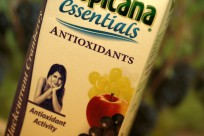Antioxidant claims on foods

Antioxidants can be found in most foods, especially in fruits and vegetables, but we see more and more food products on the shelves with antioxidant claims. These antioxidant claims crop up everywhere: from beverages to chocolates. Food producers do this because of the very high consumer awareness of the term antioxidants. Consumers believe that a high intake of antioxidants will protect them from ageing, cancer, heart disease and other diseases. This awareness already started in the 1990s when mainly beverage producers launched so called ACE drinks, which contained the three antioxidant vitamins vitamin A, C and E. Now food producers are adding supper fruits such as red berries, pomegranate and acai. When the food producer claims antioxidants, they are mainly looking at the total content of antioxidants and not at their biological activity. The antioxidant activity of foods is mainly expressed as FRAP, ORAC or TEAC values, all of which are measured in a test tube. In future the antioxidant activity should be measured in humans, by determining the quantities absorbed in the blood and tissues.
European Legislation
In the European Community, currently no legal rules exist regarding the declaration of antioxidants. For example, there is no definition for foods with claims such as "contains antioxidants" or "high in antioxidants". However, some food companies have already been rapped on their knuckles by health authorities. In 2007 an antioxidant claim by the well known smoothie producer Innocent that its fruit juice contained more antioxidants than a five-a-day portion was found not substantiated. In the same year the UK Tea Council was forbidden to make any further claims about the antioxidant potentials of tea.
USA legislation
The FDA considers the antioxidant claim as a nutrient content claim. This implies that an antioxidant claim can only be made for nutrients with a Recommended Daily Intake (RDI) and with a recognized antioxidant activity, such as ascorbic acid or vitamin E, but not for phytochemicals with strong antioxidant activity, such as quercetin, elagic acid or cyanidin. For the use of a “high” antioxidant claim, the food must contain 20% or more of the RDI per serving. Beta-carotene may also be the subject of an antioxidant claim when the corresponding level of vitamin A is sufficient to qualify for the claim.
Overdosage of antioxidants
Although some levels of antioxidants in the diet are required for good health, there is considerable doubt as to whether antioxidant supplementation is beneficial, and if so, which antioxidant is beneficial and in what amounts. Also, there is a risk of over consumption. Some antioxidants will act as pro-antioxidants when consumed in high quantities and in combination with factors such as exposure to pollution, smoking and excessive exercise. One famous study called the "Alpha Tocopherol, Beta Carotene Cancer Prevention Study", tried to determine whether taking vitamin E and beta carotene daily reduced the risk of lung cancer. In this study 18% more lung cancers developed in the people taking the antioxidant supplements, the opposite of what the researchers expected.


 Antioxidants can be found in most foods, especially in fruits and vegetables, but we see more and more food products on the shelves with antioxidant claims. These antioxidant claims crop up everywhere: from beverages to chocolates. Food producers do this because of the very high consumer awareness of the term antioxidants. Consumers believe that a high intake of antioxidants will protect them from ageing, cancer, heart disease and other diseases. This awareness already started in the 1990s when mainly beverage producers launched so called ACE drinks, which contained the three antioxidant vitamins vitamin A, C and E. Now food producers are adding supper fruits such as red berries, pomegranate and acai. When the food producer claims antioxidants, they are mainly looking at the total content of antioxidants and not at their biological activity. The antioxidant activity of foods is mainly expressed as FRAP, ORAC or TEAC values, all of which are measured in a test tube. In future the antioxidant activity should be measured in humans, by determining the quantities absorbed in the blood and tissues.
Antioxidants can be found in most foods, especially in fruits and vegetables, but we see more and more food products on the shelves with antioxidant claims. These antioxidant claims crop up everywhere: from beverages to chocolates. Food producers do this because of the very high consumer awareness of the term antioxidants. Consumers believe that a high intake of antioxidants will protect them from ageing, cancer, heart disease and other diseases. This awareness already started in the 1990s when mainly beverage producers launched so called ACE drinks, which contained the three antioxidant vitamins vitamin A, C and E. Now food producers are adding supper fruits such as red berries, pomegranate and acai. When the food producer claims antioxidants, they are mainly looking at the total content of antioxidants and not at their biological activity. The antioxidant activity of foods is mainly expressed as FRAP, ORAC or TEAC values, all of which are measured in a test tube. In future the antioxidant activity should be measured in humans, by determining the quantities absorbed in the blood and tissues.